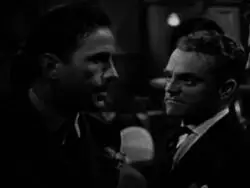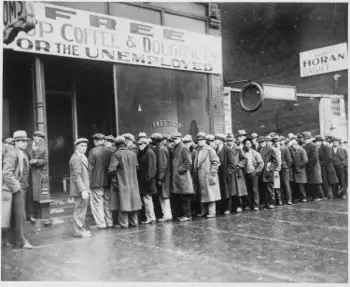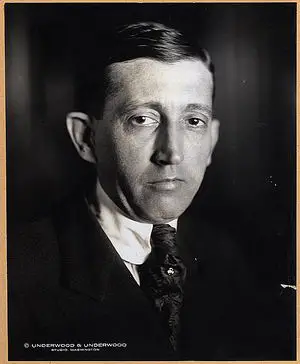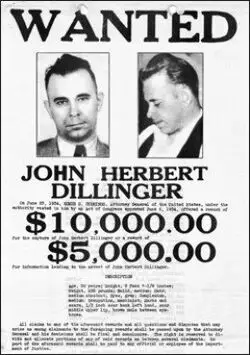Difference between revisions of "The Hays Code, Gangsters, and Prohibition: How did 1934 change Hollywood"
m (Admin moved page The Hays Code, Gangsters, and Prohibition: How did 1934 change Hollywood? to The Hays Code, Gangsters, and Prohibition: How did 1934 change Hollywood) |
|
(No difference)
| |
Latest revision as of 14:45, 22 September 2021
1934 was a pivotal year for the United States. Americans were enduring the fifth year of the Great Depression and the rural population was in an extreme state of suffering that had begun prior to the stock market crash in October 1929. Urban citizens fared little better, yet those who had a nickel to spare spent it at the moves. Particularly popular throughout the decade were gangster films. The films of this genre criticized many aspects of society and portrayed the gangster as a victim of the system. Moviegoers were able to identify with film gangsters as they too were stressed by the task of financial survival.[1] Audiences were enthralled by the characters on screen that were living freely and without responsibility. Due to the great success of these films, primarily shot at Warner Brothers Studios, actors such as James Cagney, Edward G. Robinson, and newcomer Humphrey Bogart became movie stars.
The popularity of these actors and the genre as a whole was due in part to the uncensored cinematic violence and sexual innuendo portrayed on screen. The extra-cinematic exploits of such outlaws as John Dillinger and Charles “Pretty Boy” Floyd, coupled with the rise in crime due to bootlegging during Prohibition, added to the appeal of the screen gangster. All of that changed in 1934. The gangster character changed from a courageous, enterprising individual to a weak victim of society. Evident alterations of characters and the overall atmosphere of films of this genre were due to the enforcement of the Production Code, the capture of America’s outlaws, and passage of the 21st Amendment.
Conditions and Attitudes of the U.S. in the Early 1930s
In 1933, American society was enduring what was arguably the worst year of the Depression. With the unemployment rate a staggering 24.9 percent, and honest jobs scarce, “dishonest ones sometimes seemed more attractive than standing in soup lines.”[2][3]The real-life outlaws and gangsters of the day——— John Dillinger, "Pretty Boy" Floyd, and Al Capone——— were portrayed to the public as having anti-establishment attitudes and being free of the daily burdens with which average citizens were encumbered.
At the theaters, moviegoers vicariously lived out the feelings they shared with gangsters. Those fortunate enough to have a few coins in their pockets to spend at the movies were not immune to the dire suffering of those in their community. People were angry and shared a common enemy with Dillinger and the like: banks and the government. Lorena Hickcock, who traveled throughout the country as chief investigator for the head of the Federal Emergency Relief Administration (FERA), Harry Hopkins, reported via letters on the horrific living conditions many Americans were forced to endure. In a letter dated August 6, 1933 from Pennsylvania she wrote that those with whom she had spoken did not “see any let-up” of the Depression. The following day she witnessed a man “re-soling shoes for his family with pieces of automobile tire.”[4]October found Hickock in New York City where she reported that 1.25 million people were on relief. More importantly, she noted that another one million needed but were not receiving relief. She witnessed some of those one million who were “barely existing, undernourished, in rags, constantly threatened with eviction from their homes, utterly wretched and hopeless, their nerves taut, their morale breaking down.” The impoverished of New York City were a diverse group represented by “business and professional men, immigrants, uneducated, and intelligent and educated.”[5]With poverty on every street in every neighborhood, no one remained ignorant to the plight of his neighbor. People wanted an escape, and they found it in the theaters.
The Hays Code
Prior to the enforcement of the Production Code in 1934, which censored films for content and morality, the movie industry was free to portray its heroes and villains more realistically and less romantically, thus providing honest insight into 1930’s society. The Code was the ultimate product of the Motion Picture Producers and Distributors of America (MPPDA) which was established in 1922. Acting as president, Will Hays helped to establish the MPPDA in order to curtail censorship that was being implemented by local and state governments.[6]
Hays, former chairman of the Republican Party and Postmaster General under President Warren Harding, established the Studio Relations Committee (SRC) in 1928. Movie scripts and treatments had to pass before the SRC, which then made recommendations to the studio for editing. These recommendations were generally overlooked by studio executives who continued to produce films that depicted very liberal attitudes toward violence, sex, and drinking. Faced with harsh backlash from community and religious leaders, Hays realized that more severe action had to be taken. The Motion Picture Production Code (MPPC) was adopted by the studios on March 31, 1930. Most studios viewed the MPPC as merely more unenforceable recommendations and dismissed the notes of the SRC.[7] As tensions continued to grow between Hollywood and religious leaders, specifically the Catholic Church, Hays placed Joseph Breen, a former journalist who had worked for the MPPDA since 1931, in charge of the SRC in 1933. An Irish American with a strong Catholic upbringing, Breen realized harsher measures needed to be taken.
On July 1, 1934 Breen replaced the ineffective SRC with the Production Code Administration (PCA). The PCA not only reviewed scripts prior to filming, it also scrutinized the final production of the film and either issued a “Seal of Approval” or returned the film to the studios to make the recommended changes. If the film was released without the approval of the PCA, the studio was fined $25,000. More importantly, without the PCA’s Seal, major urban theaters did not show a film, thus leaving the studios with no other choice but to adhere to the regulations stipulated under the Code.[8]The new “morality” stipulated by the Code had dramatic consequences for the gangster genre. The ability of the gangster to evade capture and enjoy a brief period of luxury, sin, and excitement was stifled by the first general principle of the Code, which stated that “the sympathy of the audience should never be thrown to the side of crime, wrongdoing or sin.”[9]Additionally, the Code forbade the ridicule of law enforcement and sex was off limits.

Real Life Gangsters
Until the summer of 1934, shortly after enforcement of the Code, bank robbers and gangsters moved freely throughout the American Heartland. Newspapers and radios unabashedly publicized the inept efforts of the police and the Federal Bureau of Investigation (FBI) in their attempts to capture America’s Public Enemy Number One, John Dillinger. After Dillinger and many of his peers were captured or killed in 1934, the FBI was suddenly respected while the gangster and outlaw were no longer seen as folk heroes.
John Dillinger and Charley Floyd were bank robbers. They were also murderers, but in the eyes of many ordinary citizens, these men were robbing the banks that were foreclosing on their farms and had lost their life savings. Working-class Americans in 1934 viewed banks as the enemy. In 1933 banks were being robbed and police forces were inept. Outlaws easily evaded capture at every turn, and the public at large sided with the gangsters. Citizens were angry. Their anger was directed at banks for losing their money and taking their homes, at and the government for providing little help. Thus, bank robbers, outlaws, and bootleggers became heroes to the public as this group of criminals was degrading their common enemy. The life of an outlaw seemed romantic and more appealing than that of one who was struggling to eat. Movie studio executives were keenly aware of public attitudes and took full advantage through the production of gangster films. At the theaters moviegoers vicariously lived out the feelings they shared with gangsters.
Studios were careful to depict violence and murder off-camera and filmed dead bodies as bloodless and handsome victims. This romantic vision of crime and death was true in the extra-cinematic escapades of Dillinger and his peers. The public read and heard of bank robberies and the entertaining escapes the outlaws made at the expense of law enforcement. Those romantic notions came to a crashing halt in 1934. received no national notoriety until On May 23, 1934, Bonnie Parker and Clyde Barrow were slaughtered in an ambush by police in Gibsland, Louisiana. On the side of a dusty road, one hundred fifty bullets pierced through the couple’s car and into their bodies. When the firing ceased, a lawman approached the vehicle and witnessed an unforgettable scene that was “‘like a slaughterhouse.’”[10]
Two months later on July 22, 1934, John Dillinger was killed by the FBI in Chicago. He was running from the FBI and local authorities when he was shot four times. The first three shots grazed John but the fourth hit him in the back of the neck, “smashing a vertebra, severing his spinal cord and tearing through his brain before exiting through his right eye.” This grizzly event took place in front of hundreds of civilian witnesses and the next morning was “front-page news around the world.”[11] Melvin Purvis, the FBI agent in charge, received plaudits from the press while the photograph of Dillinger and the details of his demise offered a stark contrast to readers across the nation. Law enforcement officers were emerging as victorious men of valor while legendary outlaws were no longer as heroic as once imagined.
The End of Prohibition
The 18th Amendment to the U.S. Constitution was ratified on January 16, 1919, and put into effect on January 17, 1920. Section One of the Amendment states “the manufacture, sale, or transportation of intoxicating liquors within, the importation thereof into, or the exportation thereof from the United States and all territory subject to the jurisdiction thereof for beverage purposed is hereby prohibited.” The Amendment was passed over the protest and veto of President Woodrow Wilson, who believed the law could not be enforced. He was correct. By 1927 in New York City alone, 32,000 speakeasies were operating. In the eyes of the public, rum runners and bootleggers were accepted, if not applauded, as heroes.
Americans wanted alcohol; therefore, since they “refused to give up their drinking habits, rum runners were regarded with open sympathy.”[12] Al Capone, perhaps the most notorious of all bootleggers, received standing ovations when he entered his favorite race tracks. Since this ilk of society was admired by the public, movie studios wasted no time in juxtaposing the likes of Al Capone and James Cagney on screen. Unfortunately for Hollywood, when Prohibition ended, so too did the need for bootleggers. The 21st Amendment to the U.S. Constitution was repealed on December 5, 1933. As the decade progressed, Prohibition and the decade that “roared” were fond and distant memories to most moviegoers. Without mobsters and bootleggers, the gangster genre may have been little more than a minor footnote in Hollywood’s history, for “crime itself helped make the 1930s a golden decade for the crime film.”[13]
Conclusion
Many people saw no futures for themselves during the Depression and were captivated by the gangsters, both real and fictional, who lived for the moment, however brief. The events of 1934 changed the opinions of movie audiences as the Hays Code dictated morality, real-life gangsters were killed in non-heroic and well publicized situations, and the end of Prohibition meant the end of the bootlegger. Although the gangster genre continued after 1934, it did so without the grit and authenticity of the pre-Code films that were made when outlaws and bootleggers lived off the screen.
Related DailyHistory.org Articles
References
- ↑ Nicole Rafter, Shots in the Mirror: Crime Films and Society(New York: Oxford University Press, 200), 21
- ↑ U.S. Department of Labor, Compensation and Working Conditions(Fall, 2001) by Albert E Schwenk and Robert VanGiezen. Bureau of Labor Statistics
- ↑ U.S. Federal Bureau of Investigation, The F.B.I. and the American Gangster. FBI.gov
- ↑ Lorena Hickock, One Third of a Nation: Lorena Hickock Reports on the Great Depression, edited by Richard Lowitt and Maureen Beasly (Urbana: University of Illinois Press, 1981), 7-11.
- ↑ Hickock, 44-45
- ↑ Richard B. Jewell, The Golden Age of Cinema: Hollywood, 1929-1945 (Malden, MA: Blackwell, 2007), 114.
- ↑ Jewell, 117
- ↑ Jewell, 133.
- ↑ Jewell, 117.
- ↑ Bryan Burrough, Public Enemies: Americas Greatest Crime Wave and the Birth of the FBI, 1933-1934(New York: Penguin Press, 2004), 359
- ↑ Burrough, 410.
- ↑ John Toland, The Dillinger Days(1963; repr.,New York: Da Capo Press, 1995), 36.
- ↑ Rafter, 19
Admin and EricLambrecht




